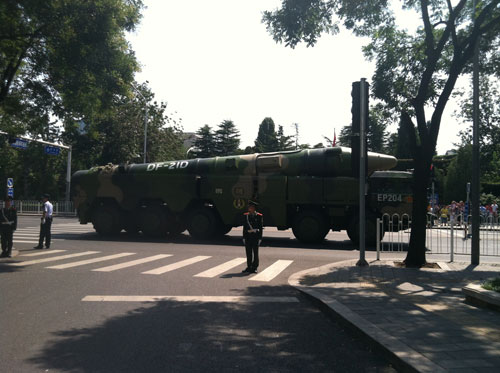It does until it gets within DF21D range (840 nm) and then all bets are off. If things get hot between the US and the PRC, there is a significant chunk of the Pacific Ocean that will be denied to any CBG: the SCS, East China Sea, waters around Japan. Once the PRC move the DF21 to their illegal artificial islands in the SCS, they will push the CBGs further back. They are launched from mobile launchers, so hard to counter.
The Dongfeng-21(CSS-5) is a Chinese medium-range, road-mobile ballistic missile.

missilethreat.csis.org
The range of the DF21D neuters a CVN because it can't deploy its strike weapon due to it being unable to get within range of any mainland PRC targets.
I will be honest and state that, at present, I am rather skeptical of the effectiveness of the DF-21D in a long-range, non-nuclear anti-shipping ballistic missile role.
Assuming some of the published information is reasonably accurate in terms of a range of 800+ n miles, Mach 10 speed, and so on, I see problems with both the OODA loop and the actual impact of the DF-21D.
Issues with the OODA are such that in order to effectively utilize DF-21D, sensors would need to be able to detect and track potential targets, and then have data links in place to cue DF-21D launchers which would be well over the horizon from the target(s). This would mean either having an asset like an MPA aircraft (which could be engaged/driven off by aircraft from a CSG), or else reliance upon some sort of long-ranged OTHR. There are issues with using OTHR as among other things they cannot really deliver target quality data, and also they can do SFA about determining what a contact is. Given the volume of shipping which transits the SCS on a daily basis, picking out which ship is a CVN, or which cluster of ships is a CSG would likely be a real problem. This in turn means that there would be difficulties in determining when a target is in range, and when to launch. Unless of course a decision was made, backed up by sufficient numbers of DF-21D's, to just fire upon every contact.
Now for the actual impact of a DF-21D, at least when fired from ~max range. My rough calculations have a flight time of ~7 minutes for around 800 n miles for a DF-21D. Now if a target vessel was steaming at 18 kts, that would mean the vessel would have moved ~2 n miles between the time of launch, and when the DF-21D would strike the original target location, assuming the CEP was completely on point. This in turn would require one or more of a few capabilities which AFAIK have yet to be documented, and in some cases would not make much sense for a ballistic missile to have.
Either there would need to be a system in place for an offboard sensor to track the targeted vessel and then use data links to relay target updates, or there would need to be a functional terminal guidance sensor aboard the ballistic missile/warhead able to provide detect and determine needed course corrections. The inbound missile or warhead would also need a sufficiently capable maneuvering ability during a terminal ballistic trajectory, in order to adjust the point of impact potentially by several km's, while literally on the fly. The other alternative would be the warhead would need to have a large area of effect. While this would certainly be possible if a nuclear warhead were to be used, I find have difficulty understanding how a conventional warhead, even one using sub-munitions, would be able to have an area of effect of 12+ sq. n miles or more.
For further food for thought, the range of an F-35C/JSM strike package can be ~770 n miles, assuming using internal fuel/weapons and a low-low-low flight path. A high-high-low flight path could extend that range out to ~970+ n miles. Using other standoff ordnance with a longer range, like the AGM-158B JASSM-ER, drop tanks, or air-to-air refueling, or some combination, could extend that range even further.
Please do not misunderstand me, I consider the possibility of anti-ship ballistic missiles a threat which needs to be considered and dealt with. However, I do not automatically consider ASBM's as being effective in creating "no-go" areas, at least not yet.



